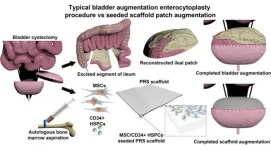Convolutional optical neural networks herald a new era for AI imaging
2024-06-26
(Press-News.org)
Convolutional Neural Networks (CNNs), with its exceptional image recognition capabilities, have performed outstandingly in the field of AI and notably within platforms like ChatGPT. Recently, a team of Chinese researchers from University of Shanghai for Science and Technology have successfully introduced the concept of CNNs into the field of optics and realized convolutional all-optical neural network, bringing revolutionary progress to AI imaging technology.
Led by Prof. Min Gu and Prof. Qiming Zhang from School of Artificial Intelligence Science and Technology (SAIST) at the University of Shanghai for Science and Technology (USST), the research team has developed an ultrafast convolutional optical neural network (ONN), which achieves efficient and clear imaging of objects behind scattering media without relying on the optical memory effect. This finding was published on June 14th in the journal Science Advances, with the title of "Memory-less scattering imaging with ultrafast convolutional optical neural networks". Dr. Yuchao Zhang, a researcher at SAIST, is the first author. Prof. Min Gu and Prof. Qiming Zhang serve as the corresponding authors.
The core of CNNs, convolutional operations, extracts local features from images and constructs more complex and abstract feature representations layer by layer, greatly advancing the fields of image processing and pattern recognition. However, applying the concept of convolution network operations to the field of optics faces the challenge of converting electronic signals into optical signals. The research team ingeniously designed an all-optical solution, performing convolution network operations directly in the optical domain, eliminating the cumbersome signal conversion process, and achieving true optical computing speeds.
The key to this research is the construction of a multi-stage convolutional ONN, composed of multiple parallel cores capable of operating at the speed of light, directly extracting features from scattered light for rapid image reconstruction. This process not only greatly improves imaging speed but also significantly enhances image quality, making imaging in complex scattering environments possible. Moreover, the convolutional ONN's computational speed reaches 1.57 Peta operations per second (POPS), providing robust support for real-time dynamic imaging.
Another highlight of this research is its multitasking capability. By simply adjusting the network structure, the same convolutional ONN can perform a variety of different image processing tasks, such as classification and reconstruction, concurrently—a first in the field of optical artificial intelligence. Prof Qiming Zhang noted, "This combination of flexibility and efficiency not only underscores the importance of convolutional networks in artificial intelligence but also opens up new avenues for optical imaging technology."
The advent of this research is not only a successful transplantation of convolutional neural networks into the optical field but also a significant boost to AI imaging technology. Prof Min Gu stated, "In the near future, convolutional optical neural networks will play an increasingly vital role in autonomous driving, robotic vision, and medical imaging."
END
ELSE PRESS RELEASES FROM THIS DATE:
2024-06-26
SINGAPORE — Scientists have generated a comprehensive map of the gene targets regulated by the transcription factors HNF4A and HNF1A in human pancreatic beta cells and liver cells. Published in the journal Nature Communications, the study revealed common and tissue-specific molecular pathways regulated by HNF4A and HNF1A, two proteins that possess important functions governing the development and function of the pancreas and liver.
Notably, the scientists identified several novel gene targets in pancreatic beta cells, the cells responsible for insulin ...
2024-06-26
More than 100,000 oil and gas wells across the western U.S. are in areas burned by wildfires in recent decades, a new study has found, and some 3 million people live next to wells that in the future could be in the path of fires worsened by climate change.
Researchers from the University of California, Berkeley, said their analysis, which was published last week in the journal One Earth, is the first to examine historical and projected wildfire threats on oil and gas facilities in the U.S. While the public health effects of scorched and damaged drill sites are unclear, researchers said the study is a necessary step ...
2024-06-26
DALLAS, JUNE 25, 2024 — Cardiovascular disease is the leading cause of death for women, and gaps in care and access persist between women and men. Addressing those gaps could lead to an increase of at least 1.6 million years of quality life and boost the U.S. economy by $28 billion annually by 2040, according to a new report published today by the American Heart Association and the McKinsey Health Institute (MHI). To help close these gaps and foster gender specific cardiovascular disease science into implementation, the Association, observing 100 years of lifesaving service as the world’s leading nonprofit organization ...
2024-06-26
(Santa Barbara, Calif.) — Computers have come so far in terms of their power and potential, rivaling and even eclipsing human brains in their ability to store and crunch data, make predictions and communicate. But there is one domain where human brains continue to dominate: energy efficiency.
“The most efficient computers are still approximately four orders of magnitude — that’s 10,000 times — higher in energy requirements compared to the human brain for specific tasks such as image processing and recognition, although they outperform the brain in tasks like mathematical calculations,” said UC Santa Barbara ...
2024-06-25
Biogenic monoamines — molecules like dopamine and serotonin — are famous for their role as the brain’s emissaries of mood, learning and memory, stress mechanisms, and fight-or-flight responses in the body.
But these neurotransmitters existed in nature long before brains popped up in the evolutionary tree. They’re prevalent in plants, bacteria, and single-cell organisms as well, but their functions there are far less understood.
Scientists at the Morgridge Institute for Research have added another task for ...
2024-06-25
DURHAM, N.C. -- There’s a strong chance that last week’s scorching temperatures were even hotter than reported for those living in underserved urban areas.
It’s been well established that more impoverished areas within cities are typically hotter than their wealthier neighborhoods. Dubbed “urban heat islands,” these communities have more buildings, less vegetation and somewhat higher population density, which combine to produce the heating effect.
New research from environmental engineers at Duke University has shown that citizen science tools used to gauge heat in these ...
2024-06-25
A functional, healthy bladder is something that many of us take for granted. Yet millions of Americans deal with bladder issues, ranging from temporary inconveniences to long-lasting conditions. While many bladder disorders can be managed with non-invasive solutions, some conditions may require surgery to restore bladder function.
In patients with major bladder issues, a cystectomy may need to be performed. In this procedure, some or all of the bladder is removed (reasons for this may include acute trauma or bladder cancer). Sometimes, to compensate for the loss of tissue, the bladder is augmented (made larger), typically with ...
2024-06-25
American Geophysical Union
Press Release 24-27
For Immediate Release
25 June 2024
This press release is available online at: https://news.agu.org/press-release/worlds-lakes-less-resilient-climate-pollution/
AGU press contact:
Rebecca Dzombak, news@agu.org (UTC-4 hours)
Contact information for the researchers:
Ke Zhang, Chinese Academy of Sciences, kzhang@niglas.ac.cn (UTC+8 hours)
WASHINGTON — Nearly half of the world’s large lakes have lost resilience, or the ability to bounce back after an abrupt disturbance, in recent ...
2024-06-25
Vanderbilt University Medical Center (VUMC) researchers are touting data from a multicenter, international phase 2 clinical trial showing a new, curative treatment for sickle cell disease (SCD).
The therapy, nonmyeloablative haploidentical bone marrow transplant (BMT) with thiotepa and posttransplant cyclophosphamide (PTCy), is proving to have equivalent efficacy and one-fifth the cost as recently FDA-approved myeloablative gene therapy options, according to Michael DeBaun, MD, MPH, director of the Vanderbilt-Meharry Center ...
2024-06-25
In a significant finding, researchers from The Jackson Laboratory (JAX) and UConn Health have discovered that sodium valerate, a short-chain fatty acid produced by gut microbes, can dramatically reduce binge drinking behavior and blood ethanol concentration in mice. The study, reported June 17 in Microbiome, offers promising insights into the gut-brain axis and presents a novel therapeutic approach for excessive alcohol use.
We are interested in physiological addiction genetics and genomics to identify new drug targets for treating addiction/overdose.
The research team, led by Yanjiao Zhou, M.D., ...
LAST 30 PRESS RELEASES:
[Press-News.org] Convolutional optical neural networks herald a new era for AI imaging




